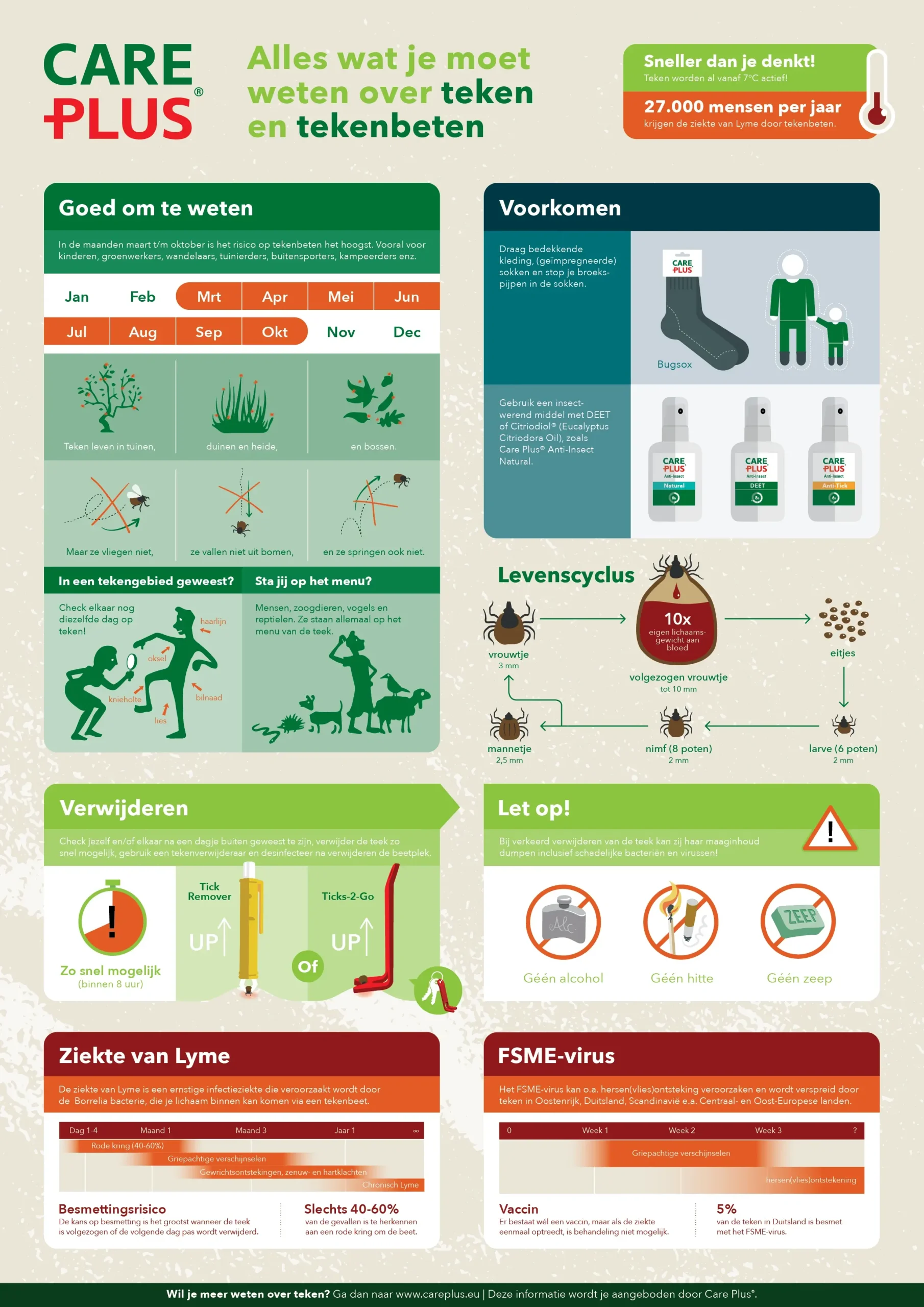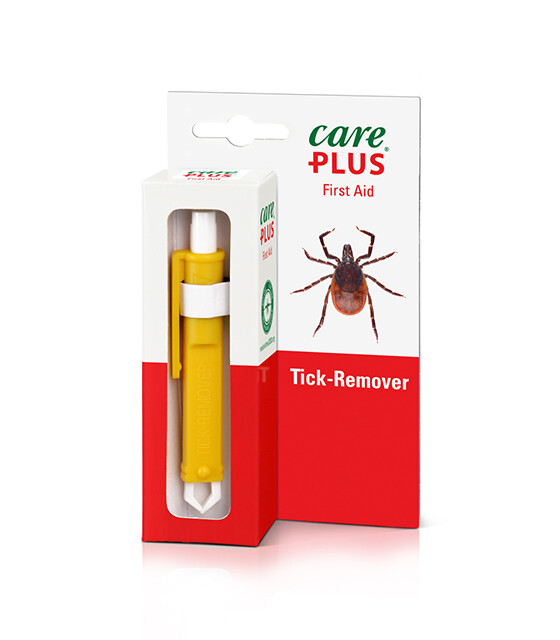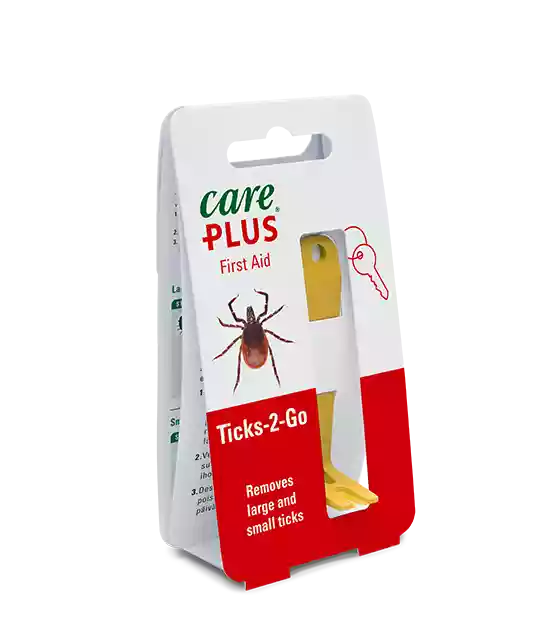How can you safely remove a tick?
Removing a tick must be done quickly and safely. Always use a special tick removal tool such as the Care Plus® Ticks-2-Go or Care Plus® Tick Remover. In just a few steps, you can properly remove a tick and minimise the risk of infection with the Borrelia bacterium, which causes Lyme disease.
Warnings when removing a tick
Do not anaesthetise the tick with alcohol or other numbing agents, and never attempt to heat it, even with a cigarette. Anaesthetising or heating the tick can shock it, causing it to release disease-causing pathogens through its saliva.
CAUTION! Incorrect removal of the tick may cause it to regurgitate its stomach contents, including harmful bacteria and viruses!
Removing a tick with the Ticks-2-Go
The Ticks-2-Go has two openings, suitable for ticks of various sizes.
1. Hold the Ticks-2-Go with your thumb and index finger and gently position the gripper over the tick, as close to the skin as possible.
2. Remove the tick with a few gentle tugs straight out from the skin.
3. Disinfect the bite area and note the date of the bite.
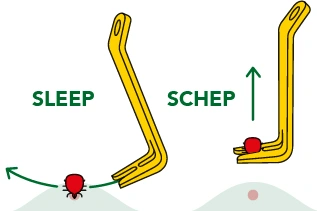
Tick Removal with a Tick Remover
- 1. Hold the tick remover with your thumb and middle finger and press your index finger on the back of the tool to open the gripper.
- 2. Gently position the gripper over the tick, as close to the skin as possible, and allow the gripper to close – and then let the gripper close.
- 3. Then, with a few gentle tugs, pull the tick straight out from the skin.
- 4. Disinfect the bite area and note the date of the bite.
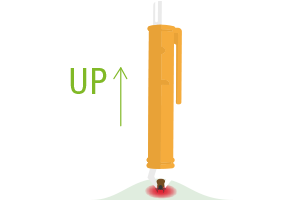
*The tick remover is mainly suitable for adult ticks. Small ticks and nymphs may be too small to be removed by the tick pen.
Care Plus Ticks-2-Go
Remove a tick in no time with our Ticks-2-Go. Suitable for adult ticks, small ticks and nymphs. Easily attach this tick remover to your keychain.
Anti-tick spray
Whether you’re in your garden, spending a day in nature, or visiting a bungalow park or camping site: you always want to prevent a tick bite. One bottle of our anti-tick spray is sufficient for one person for three weeks of daily use.
Use Care Plus® Anti-Tick safely. Read the label and product information before use.
Preventing tick bites
Prevention is always better than cure. That’s why, in addition to tick removers and pens, Care Plus® also offers products that protect against tick and mosquito bites. Apply Anti-Insect, with or without DEET, to exposed skin. You can also wear insect-repellent socks to protect your ankles and legs. Additionally, we have some tips to reduce the risk of tick bites.
Tips and Advice
Before spending time outdoors, such as playing sports, having a picnic, or walking the dog, be sure to check the tick radar for expected tick activity in your area. After any outdoor activities, regularly check yourself, family members and pets for ticks. If a tick has attached to the skin despite preventive measures, remove it as soon as possible, ideally within 8 hours, using a special tick removal tool. Note the date and location of the bite in case symptoms occur.
Frequently Asked Questions about Tick Removal
How do I know if a tick has been properly removed?
A tick has been properly removed if:
- There are no tick remnants left in the skin.
- You did not crush the tick with the removal tool or your nails.
- You did not use alcohol or fire to remove the tick.
- You removed the tick as soon as possible.
Is it harm if part of the tick remains in the skin?
Try to remove as much of the tick as possible. The remaining part will come out of the skin on its own after a few days, like a splinter. By killing the tick and removing its body, you prevent the bloodsucker from transmitting diseases. Always disinfect the bite site with a disinfectant. Do this after removing the tick.
What symptoms should I watch for after removing a tick?
If you notice discolouration or a red ring around the bite site, contact your general practitioner. Also, contact your doctor if you experience flu-like symptoms, weakness, radiating pain or joint pain. After removing a tick, note the date and location of the bite and keep an eye on the site. Discolouration may appear up to three months after the bite.
Can I remove a tick without a removal tool?
If you don’t have tweezers on hand, don’t worry! According to the Dutch Institute for Public Health and the Environment (RIVM), you can remove a tick that has just attached to the skin and has not yet engorged itself with blood using your nails. Be careful not to squeeze the tick, and never remove it with alcohol or fire. The tick may regurgitate its stomach contents into the skin out of shock, increasing the risk of infection. Therefore, it’s advisable to carry a tick removal tool when you are going to natural areas.
Is the tick removal tool also suitable for my dog or cat?
Yes, the Care Plus® tick removal tool and Ticks-2-Go are also suitable for removing ticks from pets. Use the tool in the same way as for humans. Please note! Other insect repellents such as Care Plus® Anti-Tick are not suitable for your pet. Consult a veterinarian for a suitable tick repellent for pets. Read our article ‘tick removal on a dog or cat’ for more information.
Kan ik een teek verwijderen met mijn nagels?
Nee. Gebruik nooit je nagels om een teek te verwijderen. De kop kan hierdoor in de huid blijven zitten waardoor er irritatie kan ontstaan. Daarnaast loop je de kans dat je de teek platdrukt waardoor deze zijn maaginhoud in de bijtwond leegt en je dus een verhoogde kans loopt op de ziekte van Lyme of tekenencephalitis.
Waarom zit een teek zo stevig vast in de huid?
Een teek drinkt drie tot soms meer dan tien dagen bloed van zijn gastheer. Om dit voor elkaar te krijgen, spuugt de teek allerlei stofjes de huid in. Eén van deze stofjes zorgt voor een soort van hard ‘cement’ rondom de steeksnuit. Dit goedje is zó sterk, dat er bij het verwijderen van een teek soms zelfs huid en haar meegetrokken kan worden. Daarnaast is de steeksnuit op zichzelf ook nog eens uitermate geschikt voor het binnendringen en verankeren in huid. Aan de tekenkop zit een vast puntig orgaan: het hypostoom. Hiermee zet de teek zich vast in de huid met tientallen weerhaken. Bovenop het hypostoom liggen nog twee snijdende kaakdelen: de cheliceren. Deze bewegen op en neer en bij het puntje van het hypostoom zelfs wat opzij waardoor de teek zich letterlijk kan ingraven en vastzetten in de huid. Zelfs als je de teek op de best mogelijke manier verwijdert, blijven er soms wat stukjes van de monddelen achter. Dit zweert vanzelf weer uit de huid, maar het mooist is natuurlijk als je de teek in zijn geheel weet te verwijderen.
